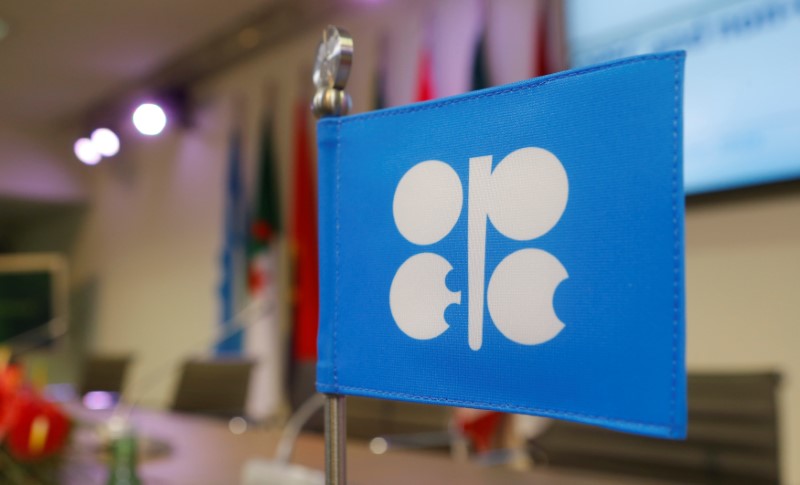 © Reuters. A flag with the OPEC logo is seen before a news conference in Vienna
© Reuters. A flag with the OPEC logo is seen before a news conference in ViennaBy Alex Lawler
LONDON (Reuters) – OPEC raised its forecast on Monday for demand for its oil in 2018 and said its deal with other producers to cut output was reducing excess oil in storage, potentially pushing the global market into a larger deficit next year.
The Organization of the Petroleum Exporting Countries also said in a monthly report it had cut its estimate of 2018 supply from non-OPEC producers and said oil use would grow faster than previously thought due to a stronger-than-expected world economy.
“The global economic growth dynamic has continued its broad-based and relatively strong momentum,” OPEC said. “The ongoing momentum could still provide some slight upside potential.”
OPEC said the world would need 33.42 million barrels per day (bpd) of OPEC crude next year, up 360,000 bpd from its previous forecast and marking the fourth consecutive monthly increase in the projection from its first estimate made in July.
The report is OPEC’s last before a Nov. 30 meeting in which the group and its allies are expected to extend their supply-cutting deal further into next year. The projections pointing to a growing 2018 supply deficit could influence debate on how long to maintain the curbs.
Oil prices, which are close to their highest since 2015, rose further towards $64 a barrel after the report was issued. Crude is still about half its level of mid-2014, when a build-up of excess supply led to a price collapse.
The 14-country producer group said its oil output in October, as assessed by secondary sources, was below the 2018 demand forecast at 32.59 million bpd, a drop of about 150,000 bpd from September.
The report’s OPEC production figures mean compliance with the supply cut by the 11 members with output targets has risen above 100 percent from 98 percent initially reported in September, according to a Reuters calculation.
“The high conformity levels of participating OPEC and non-OPEC producing countries … have clearly played a key role in supporting stability in the oil market and placing it on a more sustainable path,” the report said.
In a further sign supply excess is easing, OPEC said inventories in developed economies declined by 23.6 million barrels in September to 2.985 billion barrels, 154 million barrels above the five-year average.
“The excess overhang has fallen considerably,” said OPEC, which aims to reduce stocks to the five-year average through the supply-curbing deal.
DEMAND BOOST
Stronger demand has given tailwind to the supply cut, in which OPEC plus Russia and nine other non-OPEC producers are reducing output by about 1.8 million bpd until March 2018.
OPEC now expects oil demand to rise by 1.51 million bpd next year, up 130,000 bpd from previously, to 98.45 million bpd. World economic growth is seen accelerating to 3.7 percent, up from 3.5 percent in the previous forecast.
And in another forecast moving in OPEC’s favor, the report lowered its estimate of supply growth from non-OPEC countries next year. It now sees a rise of 870,000 bpd, down 70,000 bpd from the previous forecast. OPEC cited downward adjustments to Mexico and Norway for the revision.
OPEC and its allies are discussing extending their supply pact for as long as nine months, officials have said ahead of the Nov. 30 meeting in Vienna.
Doing so could lead to a sizeable supply shortfall next year. Should OPEC keep pumping at October’s level and other things remain equal, the market could move into a deficit of about 830,000 bpd next year, the report indicates.
Last month’s report pointed to a smaller deficit of about 310,000 bpd.
Source: Investing.com



























